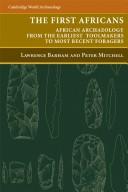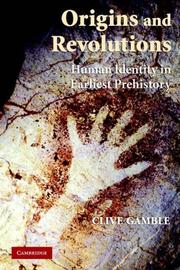| Listing 1 - 4 of 4 |
Sort by
|
Book
ISBN: 9780199604715 0199604711 1299924158 0191804606 0191668109 9780191668104 9781299924154 Year: 2013 Publisher: Oxford : Oxford University Press,
Abstract | Keywords | Export | Availability | Bookmark
 Loading...
Loading...Choose an application
- Reference Manager
- EndNote
- RefWorks (Direct export to RefWorks)
This volume brings together evidence for the cognitive, social, and technological foundations necessary for the development of hafting, or the addition of handles and shafts to previously hand-held tools, which made the tools not only more efficient, but improved their makers' chances of survival.
Tools, Prehistoric. --- Paleolithic period. --- Outils préhistoriques --- Paléolithique --- Outils préhistoriques --- Paléolithique --- Implements, Prehistoric --- Implements, utensils, etc., Prehistoric --- Prehistoric implements --- Prehistoric tools --- Eolithic period --- Old Stone age --- Palaeolithic period --- Stone age
Book
ISBN: 9781107646636 9780521888271 0521888271 9780511499661 0511437587 9780511437588 9780511438257 0511438257 9780511436901 0511436904 9786611903527 6611903526 1107201039 1281903523 0511499663 0511436122 0511435339 1107646634 9780511436123 Year: 2008 Publisher: Cambridge : Cambridge University Press,
Abstract | Keywords | Export | Availability | Bookmark
 Loading...
Loading...Choose an application
- Reference Manager
- EndNote
- RefWorks (Direct export to RefWorks)
The life history of stone tools is intimately linked to tool production, use and maintenance. These are important processes in the organization of lithic technology, or the manner in which lithic technology is embedded within human organizational strategies of land use and subsistence practices. This volume brings together essays that measure the life history of stone tools relative to retouch values, raw material constraints and evolutionary processes. Collectively, they explore the association of technological organization with facets of tool form such as reduction sequences, tool production effort, artifact curation processes and retouch measurement. Data sets cover a broad geographic and temporal span, including examples from France during the Paleolithic, the Near East during the Neolithic, and other regions such as Mongolia, Australia, and Italy. North American examples are derived from Paleoindian times to historic period aboriginal populations throughout the United States and Canada.
Industrie lithique --- Outils préhistoriques --- Histoire --- Tools, Prehistoric. --- Outils de pierre --- Economie de subsistance --- Land use --- Social archaeology --- Stone implements --- Subsistence economy --- Technology --- Tools, Prehistoric --- Implements, Prehistoric --- Implements, utensils, etc., Prehistoric --- Prehistoric implements --- Prehistoric tools --- Applied science --- Arts, Useful --- Science, Applied --- Useful arts --- Science --- Industrial arts --- Material culture --- Cost and standard of living --- Economic anthropology --- Poverty --- Flint implements --- Lithic implements --- Implements, utensils, etc. --- Debitage --- Archaeology --- Land --- Land utilization --- Use of land --- Utilization of land --- Economics --- Land cover --- Landscape assessment --- NIMBY syndrome --- History --- Analysis --- Social aspects&delete& --- Methodology --- Social archaeology. --- History. --- Analysis. --- Social aspects --- Outils préhistoriques --- Technologie --- Utilisation du sol --- Archéologie sociale --- Analyse --- Aspect social --- Outils préhistoriques. --- Histoire. --- Social Sciences --- Archeology

ISBN: 9780521612654 0521612659 9780521847964 0521847966 9780511817830 9780511457340 0511457340 9780511455315 0511455313 0511817835 1107175690 1281944661 9786611944667 0511456034 0511454279 0511453329 Year: 2008 Publisher: Cambridge : Cambridge University Press,
Abstract | Keywords | Export | Availability | Bookmark
 Loading...
Loading...Choose an application
- Reference Manager
- EndNote
- RefWorks (Direct export to RefWorks)
Africa has the longest record - some 2.5 million years - of human occupation of any continent. For nearly all of this time, its inhabitants have made tools from stone and have acquired their food from its rich wild plant and animal resources. Archaeological research in Africa is crucial for understanding the origins of humans and the diversity of hunter-gatherer ways of life. This book is a synthesis of the record left by Africa's earliest hominin inhabitants and hunter-gatherers, combining the insights of archaeology with those of other disciplines, such as genetics and palaeo-environmental science. African evidence is critical to important debates, such as the origins of stone tool making, the emergence of recognisably modern forms of cognition and behaviour, and the expansion of successive hominins from Africa to other parts of the world.
Antiquities, Prehistoric --- Prehistoric peoples --- Tools, Prehistoric --- Hunting and gathering societies --- Antiquités préhistoriques --- Homme préhistorique --- Outils préhistoriques --- Chasseurs-cueilleurs --- Africa --- Afrique --- Antiquities. --- Antiquités --- Antiquités préhistoriques --- Homme préhistorique --- Outils préhistoriques --- Antiquités --- Prehistoric antiquities --- Prehistoric archaeology --- Prehistory --- Implements, Prehistoric --- Implements, utensils, etc., Prehistoric --- Prehistoric implements --- Prehistoric tools --- Food gathering societies --- Gathering and hunting societies --- Hunter-gatherers --- Hunting, Primitive --- Ethnology --- Subsistence hunting --- Social Sciences --- Archeology

ISBN: 9780521677493 0521677491 0521860024 9780521860024 9780511618598 0511294042 9780511294044 0511295626 9780511295621 9786610959549 6610959544 1107167507 1280959541 0511296398 0511568932 051161859X 0511294840 Year: 2007 Publisher: Cambridge : Cambridge University Press,
Abstract | Keywords | Export | Availability | Bookmark
 Loading...
Loading...Choose an application
- Reference Manager
- EndNote
- RefWorks (Direct export to RefWorks)
In this study Clive Gamble presents and questions two of the most famous descriptions of change in prehistory. The first is the 'human revolution', when evidence for art, music, religion and language first appears. The second is the economic and social revolution of the Neolithic period. Gamble identifies the historical agendas behind 'origins research' and presents a bold alternative to these established frameworks, relating the study of change to the material basis of human identity. He examines, through artefact proxies, how changing identities can be understood using embodied material metaphors and in two major case-studies charts the prehistory of innovations, asking, did agriculture really change the social world? This is an important and challenging book that will be essential reading for every student and scholar of prehistory.
Human beings --- Social evolution. --- Tools, Prehistoric. --- Art, Prehistoric. --- Neolithic period. --- Agriculture --- Material culture. --- Technology and civilization. --- Homme --- Evolution sociale --- Outils préhistoriques --- Art préhistorique --- Néolithique --- Culture matérielle --- Technologie et civilisation --- Origin. --- Origines --- Outils préhistoriques --- Art préhistorique --- Néolithique --- Culture matérielle --- Art, Prehistoric --- Material culture --- Neolithic period --- Social evolution --- Technology and civilization --- Tools, Prehistoric --- Implements, Prehistoric --- Implements, utensils, etc., Prehistoric --- Prehistoric implements --- Prehistoric tools --- Civilization and machinery --- Civilization and technology --- Machinery and civilization --- Civilization --- Social history --- Technology --- Cultural evolution --- Cultural transformation --- Culture, Evolution of --- Culture --- Evolution --- Social change --- New Stone age --- Stone age --- Folklore --- Antiquity of human beings --- Origin of human beings --- Human evolution --- Prehistoric art --- Art, Primitive --- Origin of agriculture --- Agriculture, Prehistoric --- Domestication --- Origin --- Philosophy --- History --- Social Sciences --- Archeology
| Listing 1 - 4 of 4 |
Sort by
|

 Search
Search Feedback
Feedback About
About Help
Help News
News